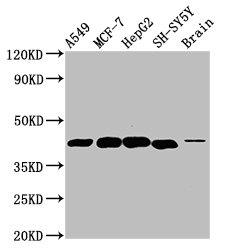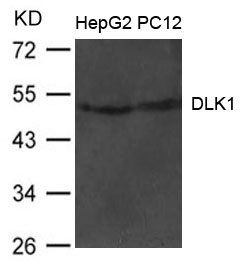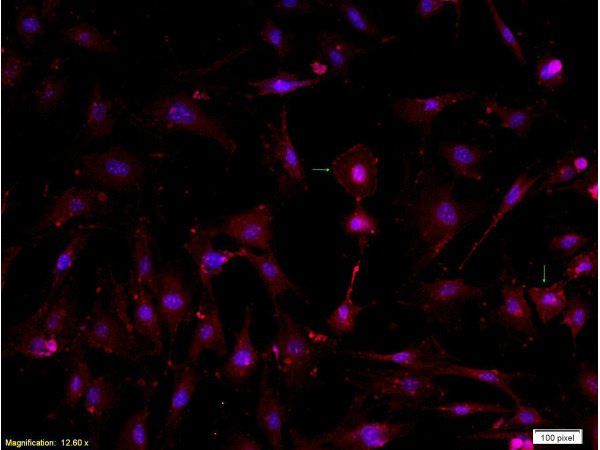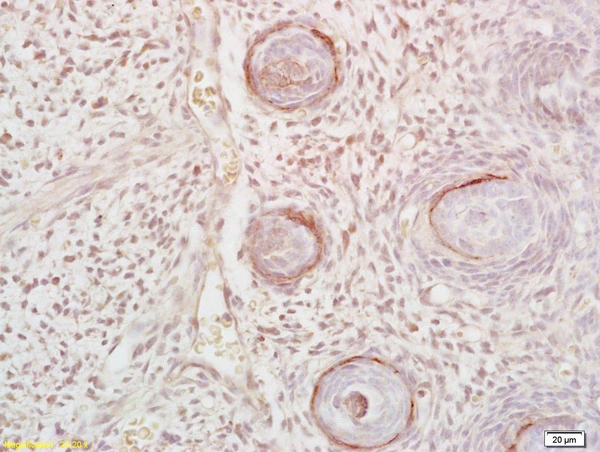![ELISA analysis of antigen using GTX60511 DLK1 antibody [3A10]. Black : Control antigen 100ng Purple : Antigen 10ng Blue : Antigen 50ng Red : Antigen 100ng ELISA analysis of antigen using GTX60511 DLK1 antibody [3A10]. Black : Control antigen 100ng Purple : Antigen 10ng Blue : Antigen 50ng Red : Antigen 100ng](https://www.genetex.com/upload/website/prouct_img/normal/GTX60511/GTX60511_20170912_ELISA_w_23061123_528.webp)
ELISA analysis of antigen using GTX60511 DLK1 antibody [3A10]. Black : Control antigen 100ng Purple : Antigen 10ng Blue : Antigen 50ng Red : Antigen 100ng
DLK1 antibody [3A10]
GTX60511
ApplicationsFlow Cytometry, ImmunoFluorescence, Western Blot, ELISA, ImmunoCytoChemistry, Other Application
Product group Antibodies
TargetDLK1
Overview
- SupplierGeneTex
- Product NameDLK1 antibody [3A10]
- Delivery Days Customer9
- Application Supplier NoteWB: 1/500 - 1/2000. ICC/IF: 1/200 - 1/1000. FACS: 1/200 - 1/400. ELISA: 1/10000. *Optimal dilutions/concentrations should be determined by the researcher.Not tested in other applications.
- ApplicationsFlow Cytometry, ImmunoFluorescence, Western Blot, ELISA, ImmunoCytoChemistry, Other Application
- CertificationResearch Use Only
- ClonalityMonoclonal
- Clone ID3A10
- ConjugateUnconjugated
- Gene ID8788
- Target nameDLK1
- Target descriptiondelta like non-canonical Notch ligand 1
- Target synonymsDLK, DLK-1, Delta1, FA1, PREF1, Pref-1, ZOG, pG2, protein delta homolog 1, delta-like 1 homolog, fetal antigen 1, preadipocyte factor 1, secredeltin
- HostMouse
- IsotypeIgG1
- Protein IDP80370
- Protein NameProtein delta homolog 1
- Scientific DescriptionThis gene encodes a transmembrane protein containing six epidermal growth factor repeats. The protein is involved in the differentiation of several cell types, including adipocytes; it is also thought to be a tumor suppressor. It is one of several imprinted genes located in a region of on chr 14q32. Certain mutations in this imprinted region can cause phenotypes similar to maternal and paternal uniparental disomy of chromosome 14 (UPD14). This gene is expressed from the paternal allele. A polymorphism within this gene has been associated with child and adolescent obesity. The mode of inheritance for this polymorphism is polar overdominance; this non-Mendelian inheritance pattern was first described in sheep with the callipyge phenotype, which is characterized by muscle hypertrophy and decreased fat mass. [provided by RefSeq, Mar 2010]
- Storage Instruction-20°C or -80°C,2°C to 8°C
- UNSPSC12352203
References
- Karapurkar JK, Kim MS, Colaco JC, et al. CRISPR/Cas9-based genome-wide screening of the deubiquitinase subfamily identifies USP3 as a protein stabilizer of REST blocking neuronal differentiation and promotes neuroblastoma tumorigenesis. J Exp Clin Cancer Res. 2023,42(1):121. doi: 10.1186/s13046-023-02694-1Read this paper

![FACS analysis of NIH3T3 cells using GTX60511 DLK1 antibody [3A10]. Green : DLK1 Red : negative control FACS analysis of NIH3T3 cells using GTX60511 DLK1 antibody [3A10]. Green : DLK1 Red : negative control](https://www.genetex.com/upload/website/prouct_img/normal/GTX60511/GTX60511_20170912_FACS_w_23061123_641.webp)
![ICC/IF analysis of U251 cells using GTX60511 DLK1 antibody [3A10]. Green : DLK1 Blue: DRAQ5 fluorescent DNA dye Red: Actin filaments ICC/IF analysis of U251 cells using GTX60511 DLK1 antibody [3A10]. Green : DLK1 Blue: DRAQ5 fluorescent DNA dye Red: Actin filaments](https://www.genetex.com/upload/website/prouct_img/normal/GTX60511/GTX60511_20170912_ICCIF_w_23061123_507.webp)
![WB analysis of human DLK1 (AA: 174-349) recombinant protein using GTX60511 DLK1 antibody [3A10]. WB analysis of human DLK1 (AA: 174-349) recombinant protein using GTX60511 DLK1 antibody [3A10].](https://www.genetex.com/upload/website/prouct_img/normal/GTX60511/GTX60511_20170912_WB_w_23061123_395.webp)





